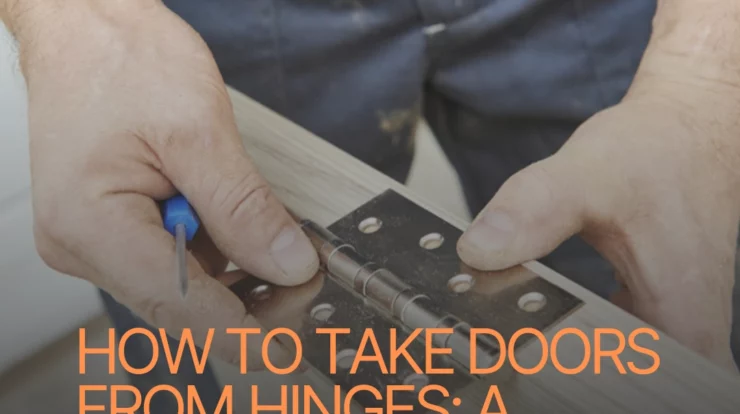
How to Take Doors from Hinges
Doors are a fundamental part of any home, serving as gateways to different rooms and spaces. Occasionally, there comes a time when you need to remove a door, whether it’s for renovation, repair, or a creative DIY project. However, this seemingly simple task can be daunting if you don’t know How to Take Doors from Hinges properly. In this comprehensive guide, we’ll walk you through the process step by step, ensuring that you can tackle this task with confidence.
Introduction
The Importance of Knowing How to Remove a Door from Hinges
Removing a door from its hinges is a skill that every homeowner or DIY enthusiast should possess. It can save you money on repair and renovation costs, offer you the flexibility to work on doors without professional help, and empower you to embark on creative projects involving doors. Moreover, it’s a handy skill to have in emergencies, such as rescuing someone trapped in a room.
Tools and Materials Required
Before we delve into the nitty-gritty of door removal, let’s first gather the necessary tools and materials. Having the right equipment is essential for a safe and efficient process. Here’s what you’ll need:
| Tools and Materials | Purpose |
|---|---|
| Screwdriver | For removing screws from the hinges |
| Hammer | To tap out stubborn hinge pins |
| Pliers | For added grip while removing hinge pins |
| Safety Glasses | To protect your eyes from debris |
| Gloves | To safeguard your hands from sharp edges |
| Drop Cloth or Tarp | To protect the floor from damage or dirt |
| WD-40 or Lubricant | For loosening stubborn or rusty hinges |
Safety Precautions
Protective Gear
Before you start, it’s crucial to prioritize safety. Always wear safety glasses to protect your eyes from debris and gloves to prevent cuts and scratches. Additionally, ensure you’re wearing appropriate clothing, such as long sleeves and pants, to minimize the risk of injury.
Ensuring a Safe Working Environment
Create a safe workspace by clearing the area around the door. Remove any obstacles, rugs, or furniture that might impede your work. Lay down a drop cloth or tarp to catch any falling screws or debris. It’s also a good idea to inform your household members or anyone nearby that you’ll be working on the door to prevent accidental disruptions.
Types of Door Hinges
Before you can remove a door, it’s essential to identify the type of hinge it has. Different hinges require slightly different approaches. Here are some common types:
Butt Hinges
Description: Butt hinges are the most common type of hinge, typically found on interior doors. They consist of two flat plates joined by a central pin.
Removal Steps:
- Removing Hinge Pins: Begin by opening the door partially. Locate the hinge pins at the top and bottom of the hinge. Use a screwdriver and hammer to tap the pins upward and out of the hinge, starting from the bottom and working your way up.
- Lifting the Door Off: With the pins removed, carefully lift the door away from the frame.
Pivot Hinges
Description: Pivot hinges are commonly used for hidden or cabinet doors. They operate on a single central pivot point.
Removal Steps:
- Detaching the Pivot Pin: Pivot hinges have a removable pivot pin. Locate the pin, which is often concealed, and use pliers to gently pull it out.
- Lifting the Door: Once the pivot pin is removed, lift the door off the pivot point.
European Hinges
Description: European hinges are often used for modern cabinet doors. They have a sleek, concealed design.
Removal Steps:
- Unfastening Screws: Open the door and locate the screws securing the hinge to the door and the cabinet frame. Use a screwdriver to remove these screws.
- Separating the Door: Once the screws are removed, carefully separate the door from the cabinet frame.
Continuous Hinges
Description: Continuous hinges, also known as piano hinges, are long, continuous strips of metal. They are commonly used for heavy doors or lids.
Removal Steps:
- Unscrewing Hinge Plates: Locate the screws securing the hinge plates to the door and frame. Use a screwdriver to remove these screws.
- Detaching the Door: Once the hinge plates are removed, lift the door away from the frame.
Preparation
Identifying the Hinge Type
Before you start removing the door, take a moment to identify the hinge type. This will ensure that you follow the correct removal steps, as we discussed in the previous section.
Gathering the Necessary Tools
Double-check that you have all the required tools and materials within reach. This will save you time and prevent any interruptions during the removal process.
Clearing the Surrounding Area
Remove any obstacles or items near the door that might obstruct your work. A clutter-free workspace is crucial for a smooth door removal process.
Removing Obstacles
Inspect the door’s path and the area around it. Ensure there are no obstacles, such as rugs or furniture, that could interfere with lifting the door off its hinges.
Step-by-Step Guide for Removing Doors
Now that you’re prepared and familiar with the hinge types, let’s dive into the detailed steps for removing doors with different hinge types.
Removing a Door with Butt Hinges
1. Removing Hinge Pins
- Begin by opening the door partially.
- Locate the hinge pins at the top and bottom of the hinge.
- Use a screwdriver and hammer to tap the pins upward and out of the hinge, starting from the bottom and working your way up.
2. Lifting the Door Off
- With the pins removed, carefully lift the door away from the frame.
- Enlist the help of a friend if the door is heavy to avoid straining yourself.
Removing a Door with Pivot Hinges
1. Detaching the Pivot Pin
- Locate the pivot pin, which is often concealed.
- Use pliers to gently pull the pivot pin out.
- Be cautious, as pivot pins can be delicate.
2. Lifting the Door
- Once the pivot pin is removed, carefully lift the door off the pivot point.
- Ensure that you have a firm grip on the door to prevent accidents.
Removing a Door with European Hinges
1. Unfastening Screws
- Open the door and locate the screws securing the hinge to the door and the cabinet frame.
- Use a screwdriver to remove these screws.
- Keep the screws in a safe place for reinstallation.
2. Separating the Door
- With the screws removed, carefully separate the door from the cabinet frame.
- Check for any additional attachments that may be holding the door in place.
Removing a Door with Continuous Hinges
1. Unscrewing Hinge Plates
- Locate the screws securing the hinge plates to the door and frame.
- Use a screwdriver to remove these screws.
- Pay attention to any additional screws that may be hidden.
2. Detaching the Door
- Once the hinge plates are removed, lift the door away from the frame.
- Continuous hinges are typically robust and can handle heavy doors.
Common Challenges and Solutions
Stuck Hinge Pins
- If hinge pins are stuck, apply a lubricant such as WD-40 to loosen them.
- Gently tap the pins with a hammer while applying pressure to help break the rust or debris holding them in place.
Painted-Over Hinges
- If the hinges are covered in paint, carefully scrape the paint away using a putty knife or a flat-head screwdriver.
- Once the paint is removed, proceed with the hinge removal steps as usual.
Misaligned Doors
- If the door is misaligned with the frame, check for any obstructions or loose screws.
- Realign the door carefully and ensure all screws are securely fastened.
Maintaining Door Hardware
Taking care of your door hardware is essential for smooth operation and longevity. Here are some maintenance tips:
Cleaning Hinges
- Regularly clean hinges with a damp cloth to remove dust and debris.
- Use a mild detergent solution for stubborn dirt.
- Dry the hinges thoroughly to prevent rust.
Lubricating Hinges
- Apply a silicone-based or graphite lubricant to hinges annually to ensure smooth movement.
- Avoid using oils, as they can attract dirt and become sticky over time.
Reattaching Doors to Hinges
Once you’ve completed your task, whether it’s a repair, renovation, or creative project, it’s time to reattach the door to its hinges.
Ensuring Proper Alignment
- Align the door carefully with the hinge locations on the frame.
- Check that the hinge pins or pivot points are in the correct positions.
Securing Hinge Pins
- Gently tap the hinge pins back into place using a hammer.
- Ensure they are fully seated and secure.
Decorating and Repurposing Doors
Now that you’ve mastered the art of removing doors from hinges, you can explore various creative projects and ideas.
Sanding and Repainting
- Sand the door’s surface to remove old paint or finish.
- Apply a fresh coat of paint or stain to match your desired look.
Creative Door Projects
- Repurpose old doors into unique pieces of furniture, such as tables, headboards, or decorative wall panels.
- Explore Pinterest and DIY blogs for endless inspiration.
Summary of Key Steps
Let’s recap the key steps for removing a door from its hinges:
- Identify the hinge type: Determine whether your door has butt hinges, pivot hinges, European hinges, or continuous hinges.
- Gather the necessary tools: Ensure you have the required tools and materials within reach.
- Clear the surrounding area: Create a safe and clutter-free workspace.
- Remove obstacles: Inspect the door’s path and remove any potential obstructions.
- Follow specific removal steps: Depending on the hinge type, follow the detailed removal steps provided in this guide.
- Address common challenges: Deal with issues like stuck hinge pins, painted-over hinges, or misaligned doors.
- Maintain door hardware: Keep your hinges clean and lubricated for smooth operation.
- Reattach doors: Ensure proper alignment and secure hinge pins.
- Explore creative projects: Consider repurposing doors for creative endeavors.
Frequently Asked Questions (FAQs)
1. How long does it take to remove a door?
The time required to remove a door varies depending on factors such as the type of hinge, the door’s size, and your experience. On average, it takes about 30 minutes to an hour.
2. Can I remove a door by myself?
Yes, you can remove a door by yourself, but it’s often easier and safer with a helper, especially for heavy doors.
3. What if the door is too heavy?
If the door is too heavy to lift on your own, consider enlisting the help of a friend or family member to assist you.
4. Are there any alternatives to removing doors?
In some cases, you can work on the door without removing it from the hinges. However, removal provides better access for certain tasks, such as painting or repairing.
5. How often should I maintain door hinges?
Regular maintenance of door hinges is recommended at least once a year. However, if you notice any issues with hinge operation, address them promptly to prevent further damage.
Conclusion
Mastering the art of removing doors from hinges is a valuable skill for any homeowner or DIY enthusiast. It empowers you to take control of home improvement projects, save on repair costs, and explore creative endeavors involving doors. By following the step-by-step guide and safety precautions outlined in this article, you can confidently tackle door removal tasks and enjoy the satisfaction of a job well done. So, roll up your sleeves, gather your tools, and start mastering the art of door removal today!






